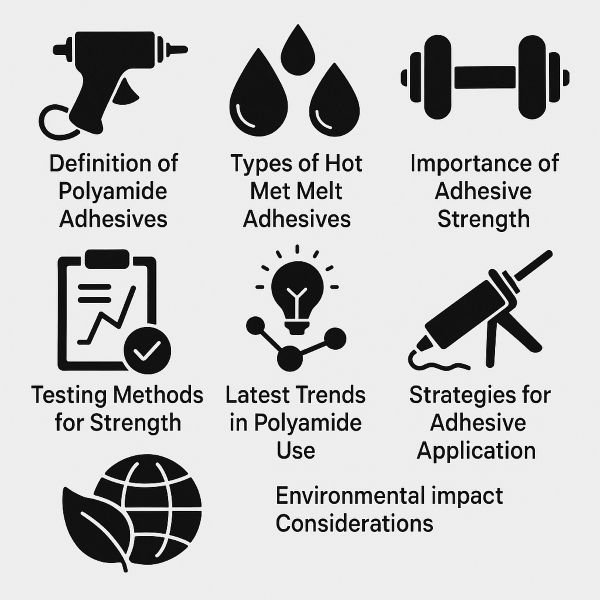
Definition of Polyamide Adhesives
Types of Hot Melt Adhesives
Importance of Adhesive Strength
Testing Methods for Strength
Latest Trends in Polyamide Use
Strategies for Adhesive Application
Environmental Impact Considerations
Frequently Asked Questions (FAQ)
Polyamide adhesives are a class of high-performance hot melt adhesives engineered for strength, durability, and adaptability. Made from synthetic polymers, they offer resistance to heat, chemicals, and mechanical impact. Their performance characteristics make them essential in demanding applications across automotive, electronics, textile, and filter manufacturing sectors. Thanks to their balanced properties, polyamide adhesives provide consistent performance where conventional adhesives might fail.
Hot melt adhesives encompass various chemistries, each developed to address unique industrial requirements. Among these, polyamide-based adhesives distinguish themselves through superior bonding strength and resistance to challenging environmental factors. Depending on the formulation, polyamides can offer:
Textile bonding capabilities for flexible, porous substrates
High-temperature resistance for thermal protection applications
Chemical durability for aggressive environments
Impact resilience for mechanical stress or vibration
This versatility allows polyamide hot melts to meet specific engineering demands across sectors.
Adhesive strength is a critical performance metric that determines how reliably an adhesive maintains a bond under stress. In high-stakes industries, weak bonds can result in product failure. Polyamide adhesives are valued for their ability to deliver strong and consistent adhesion, even in conditions involving temperature fluctuation, movement, or chemical exposure. Applications such as textile lamination or automotive harness encapsulation often rely on the dependable strength offered by polyamide-based systems.
To verify the reliability of polyamide adhesives, various mechanical tests are conducted:
Tensile strength tests measure resistance to pulling forces
Shear strength tests evaluate performance under sliding forces
Peel tests assess bond integrity when subjected to separating forces at an angle
These standardized methods ensure that adhesives meet the mechanical and environmental demands of their intended use. Testing validates not just bond strength, but long-term durability under specific application stresses.
Polyamide adhesives are increasingly being adopted for next-generation manufacturing challenges. Key trends include:
Integration into lightweight composite systems for automotive and aerospace
Miniaturized electronics assembly requiring high thermal stability and precise dispensing
Sustainability-driven demand for longer-lasting, high-efficiency bonding solutions
Textile and nonwoven assembly where strength must coexist with flexibility and low odor
These trends demonstrate that polyamide adhesives are not only keeping pace with technological evolution but actively enabling it.
To maximize the performance of polyamide adhesives, follow these strategic guidelines:
Surface Preparation: Clean and dry surfaces ensure maximum adhesion.
Temperature Management: Apply adhesives at the specified melt range for optimal flow and bonding.
Application Control: Use precision equipment (e.g., nozzles, slot dies) to ensure even distribution.
Bonding Pressure: Apply adequate pressure to eliminate air pockets and promote uniform adhesion.
Implementing these strategies helps achieve strong, repeatable bonds across different substrates and process environments.
Polyamide hot melt adhesives can contribute positively to sustainability efforts. Many formulations are solvent-free and offer:
Reduced waste through longer product lifespan
Minimized rework due to superior bond integrity
Lower emissions during application compared to solvent-based systems
Compatibility with energy-efficient dispensing equipment
These characteristics make polyamide adhesives an environmentally conscious choice for manufacturers seeking performance without compromising on ecological responsibility.
What are polyamide adhesives?
They are hot melt adhesives made from synthetic polyamides, known for high bonding strength, thermal resistance, and chemical durability.
What types of hot melt adhesives exist?
Hot melts include EVA, APAO, PUR, and polyamide types—each with unique properties. Polyamide excels in high-temperature and impact-resistant applications.
Why is adhesive strength important?
Strong adhesives ensure durability under mechanical, thermal, and chemical stress—essential for product safety and lifecycle performance.
How is adhesive strength tested?
Common tests include tensile, shear, and peel assessments to verify how adhesives perform under different load types and directions.
What are current trends in polyamide adhesive use?
Trends include increasing use in lightweight automotive structures, sustainable textiles, precision electronics, and industrial filtration systems.
What are best practices for applying polyamide adhesives?
Ensure surfaces are clean, maintain correct melt temperature, apply evenly, and use bonding pressure to guarantee consistent results.
What is the environmental impact of these adhesives?
Polyamide hot melts are typically solvent-free, produce low emissions, and contribute to longer product life—supporting reduced environmental footprint.
Are there different grades of polyamide adhesives?
Yes, grades vary by melt point, flexibility, chemical resistance, and intended substrate—allowing tailored use in textiles, electronics, or automotive.